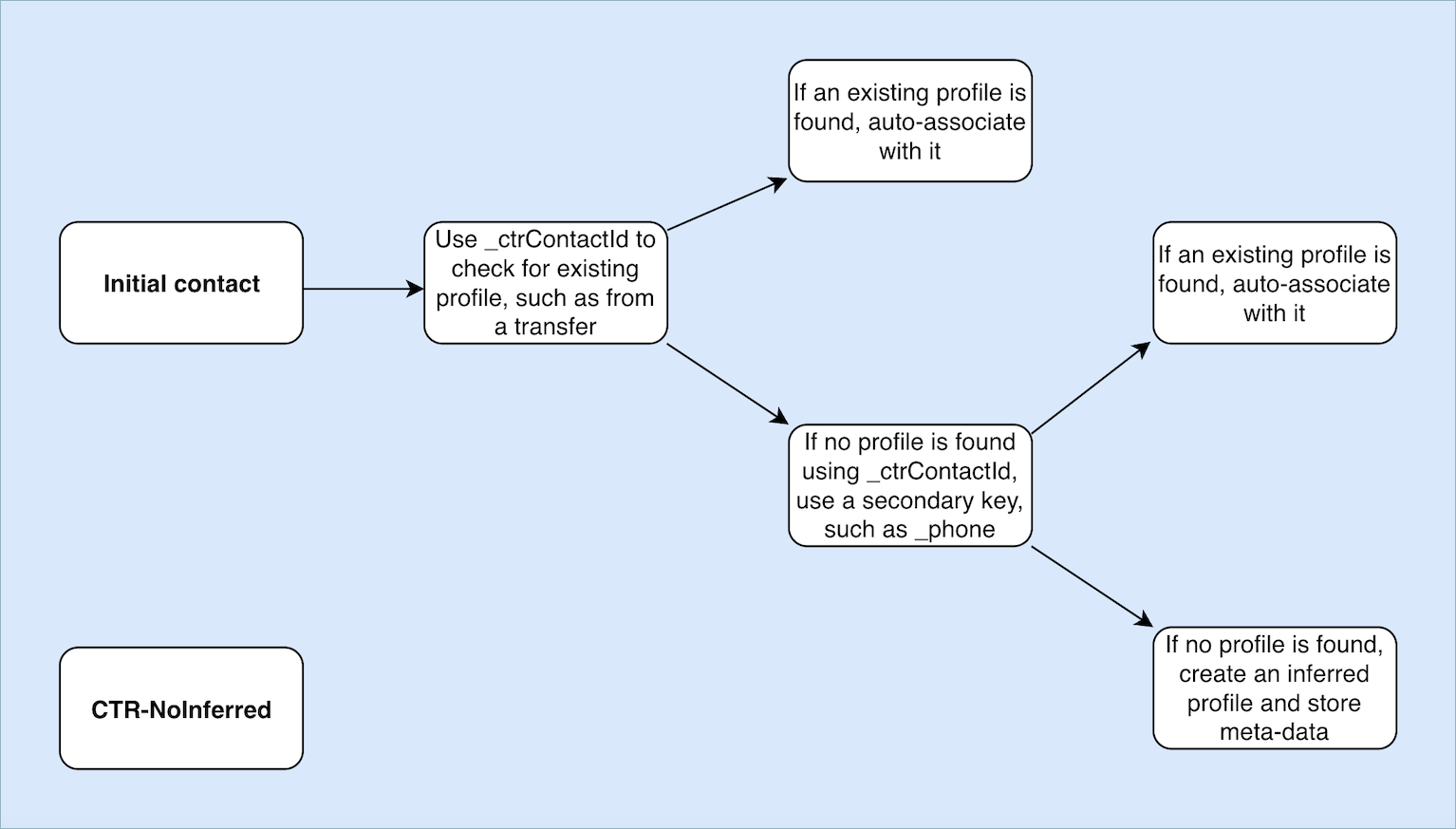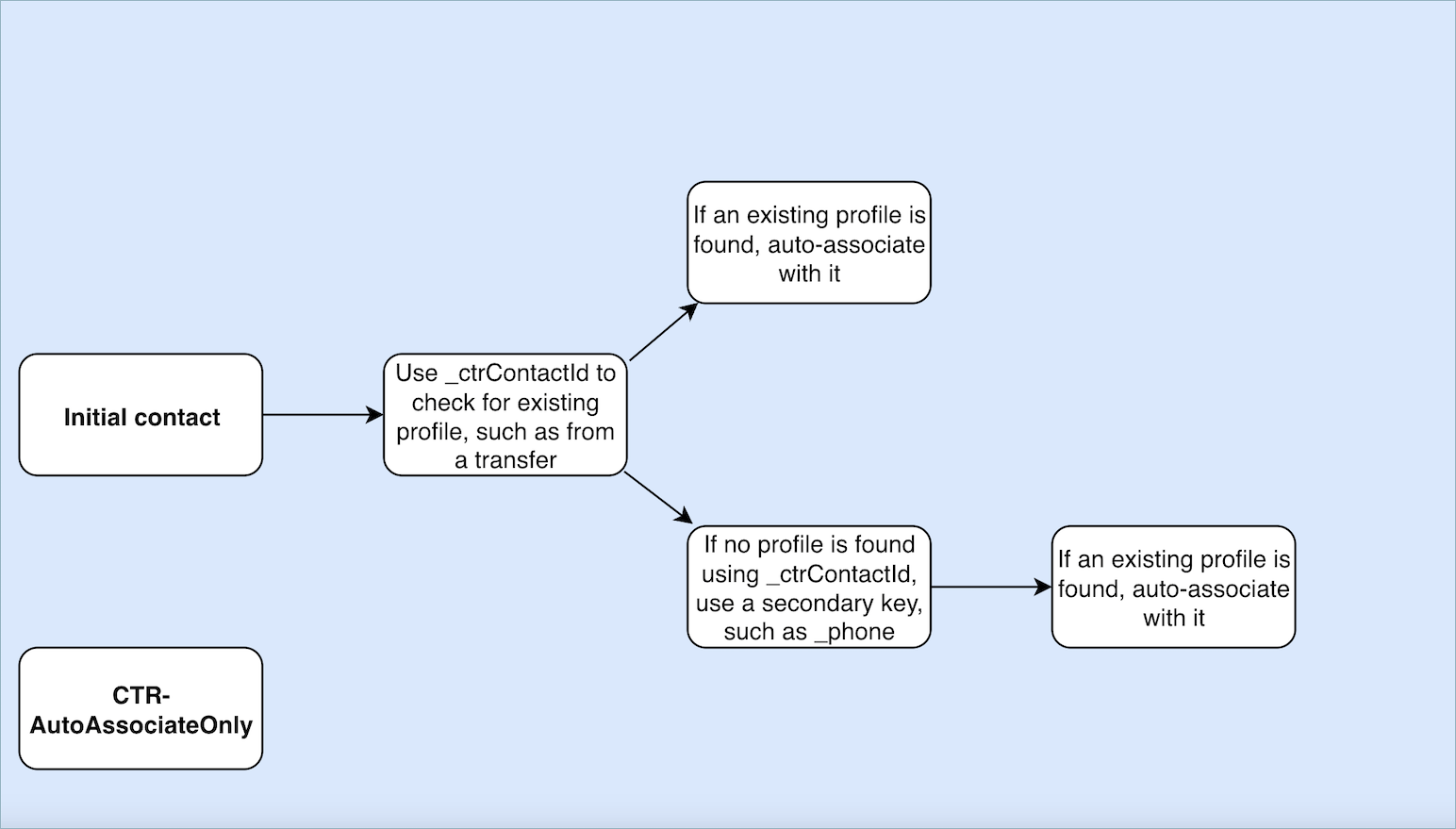Contact record templates in Amazon Connect Customer Profiles
A Contact Record serves as a profile object that captures essential meta-data from various contact events, such as phone calls or chats. It plays a vital role in documenting and analyzing interactions with customers.
When a contact event takes place, there are three distinct default templates that can be applied to your domain. These templates serve as configuration options, governing how the contact event is handled within the system. Each template defines specific rules and actions, allowing you to tailor the processing of contact events according to your business needs.
Create inferred profiles and auto-associate profiles (CTR-NoInferred)
Description
When the CTR-NoInferred template is used and a contact event, such as a phone
call takes place, a specific process is initiated to handle the data. Initially,
the system uses the _ctrContactId key to search for an existing
profile associated with the contact event. If a matching profile is found, the
contact event is automatically associated with that profile. However, if no
existing profile is found using the _ctrContactId key, the system
proceeds to search for a profile using a secondary key called
_phone. This key is used to locate an existing profile based on
the phone number associated with the contact event. When a matching profile is
found, the contact event is automatically associated with that profile.
In cases where neither the _ctrContactId key nor the
_phone key yield an existing profile, the system creates a new
inferred profile. This inferred profile is then populated with the meta-data
from the contact event, ensuring that the information is captured and stored
within the system.
This process ensures efficient handling of contact events, promoting auto-association with existing profiles and enabling the creation of inferred profiles when necessary. By leveraging these mechanisms, organizations can maintain a comprehensive record of customer interactions and effectively manage their contact event data within the system.
It is recommended to use the CTR-NoInferred template as the default behavior due to its significant advantages, especially in reducing duplicate profiles

Auto-associate profiles only (CTR-AutoAssociateOnly)
Description
The CTR-AutoAssociateOnly template functions similarly to the CTR-NoInferred template with one important distinction: it does not create an inferred profile when no existing profile can be found for auto-association.
When a contact event, such as a phone call, takes place, the
CTR-AutoAssociateOnly template uses the _ctrContactId key to search
for a matching existing profile. If a profile is found, the contact event is
automatically associated with that profile.
However, if no existing profile is found using the _ctrContactId
key, the template employs a secondary search mechanism using the
_phone key. It searches for an existing profile associated with
the same phone number as the contact event. If a matching profile is found, the
contact event is auto-associated with that profile.
The purpose of using the CTR-AutoAssociateOnly template is to enable automatic association with existing profiles while maintaining strict control over profile creation. Unlike the CTR-NoInferred template, this template prevents the creation of inferred profiles when no match is found. It ensures that profiles are only created manually, providing organizations with a higher level of control and accuracy in profile management.
By utilizing the CTR-AutoAssociateOnly template, organizations can leverage auto-association while adhering to specific rules regarding profile creation. This approach allows for streamlined contact event handling and precise control over the profile ecosystem, ensuring accurate data representation and facilitating efficient customer management.

Create inferred profiles only (CTR)
Description
The CTR template relies solely on the _ctrContactId key to search
for an existing profile, and it automatically associates the contact event with
the profile if a match is found. However, in cases where no existing profile is
found, the template creates an inferred profile and populates it with the
contact event meta-data.
Although this behavior ensures that contact events are captured even when no pre-existing profile exists, it can potentially result in the creation of numerous inferred profiles. This abundance of inferred profiles may lead to the issue of duplicate profiles within the system.
To address this concern and promote better profile management practices, we highly recommend utilizing the CTR-NoInferred template as the default option. By using the CTR-NoInferred template, the system eliminates the creation of inferred profiles, thereby reducing the occurrence of duplicate profiles. This template allows for a more streamlined and efficient handling of contact events, resulting in improved data integrity and accuracy.
By adopting the CTR-NoInferred template as the default choice, organizations can optimize their profile management processes, minimize data duplication, and ensure a more reliable representation of customer interactions.

Contact record template usage examples
Amazon Connect admin website
-
In the Amazon Connect admin website, when creating a new domain, you have the option to select the desired CTR behavior. This can be done through the radio button options available in the Profile creation and auto-association section. Similarly, when selecting an existing domain, the radio button option will reflect the behavior previously associated with that domain.
-
When editing a currently enabled domain, the Domain details page will display the currently applied behavior in the Profile creation and auto-association section. By choosing the Edit button in the header of this section, you will be redirected to the Edit Profile creation and auto-association page. Here, you can choose a different behavior according to your requirements.
-
Alternatively, if you are viewing the CTR mapping from the Data mapping page, you can choose the Change template button. This action will also take you to the Edit Profile creation and auto-association page, where you can select a different behavior that suits your needs.
These options provide you with flexibility in managing the CTR behavior for your domains, allowing you to easily customize and modify the settings based on your specific preferences or evolving business requirements.
AWS CLI
-
To use the CTR-NoInferred template, run the following command on the CLI:
aws customer-profiles put-profile-object-type --domain-name {domain} --object-type-name CTR --description "Creates inferred profiles and auto-associates profiles" --template-id CTR-NoInferred -
To use the CTR-AutoAssociateOnly template, run the following command on the CLI:
aws customer-profiles put-profile-object-type --domain-name {domain} --object-type-name CTR --description "Auto-associate with profiles only" --template-id CTR-AutoAssociateOnly -
To use the CTR template, run the following command on the CLI:
aws customer-profiles put-profile-object-type --domain-name {domain} --object-type-name CTR --description "Creates inferred profiles only" --template-id CTR
API
For information on using the API, see PutProfileObjectType
How to update Contact Record type in the AWS Console
-
In the Customer Profiles console, select View Details in the Customer Profiles domain section.

-
On the Domain details page, choose Edit in the Profile creation and auto-association section.

-
Select the desired Contact Record behavior you would like to apply to your Domain and choose Save.

Automatically add names from email contacts to a profile
You can set up a flow to populate a name from an email contact to the customer's profile. Use the Customer profiles block, configured to use the Update profile action.